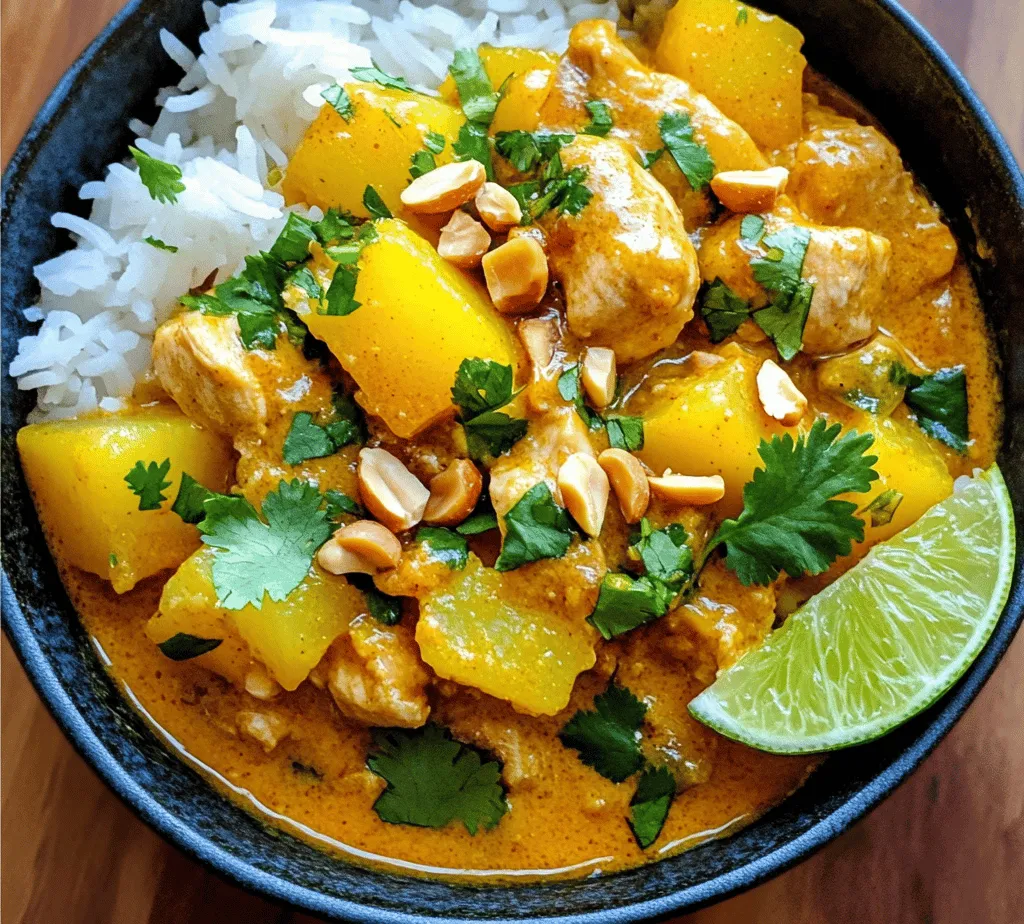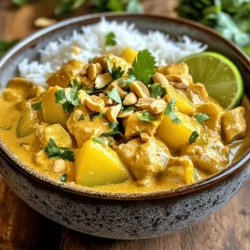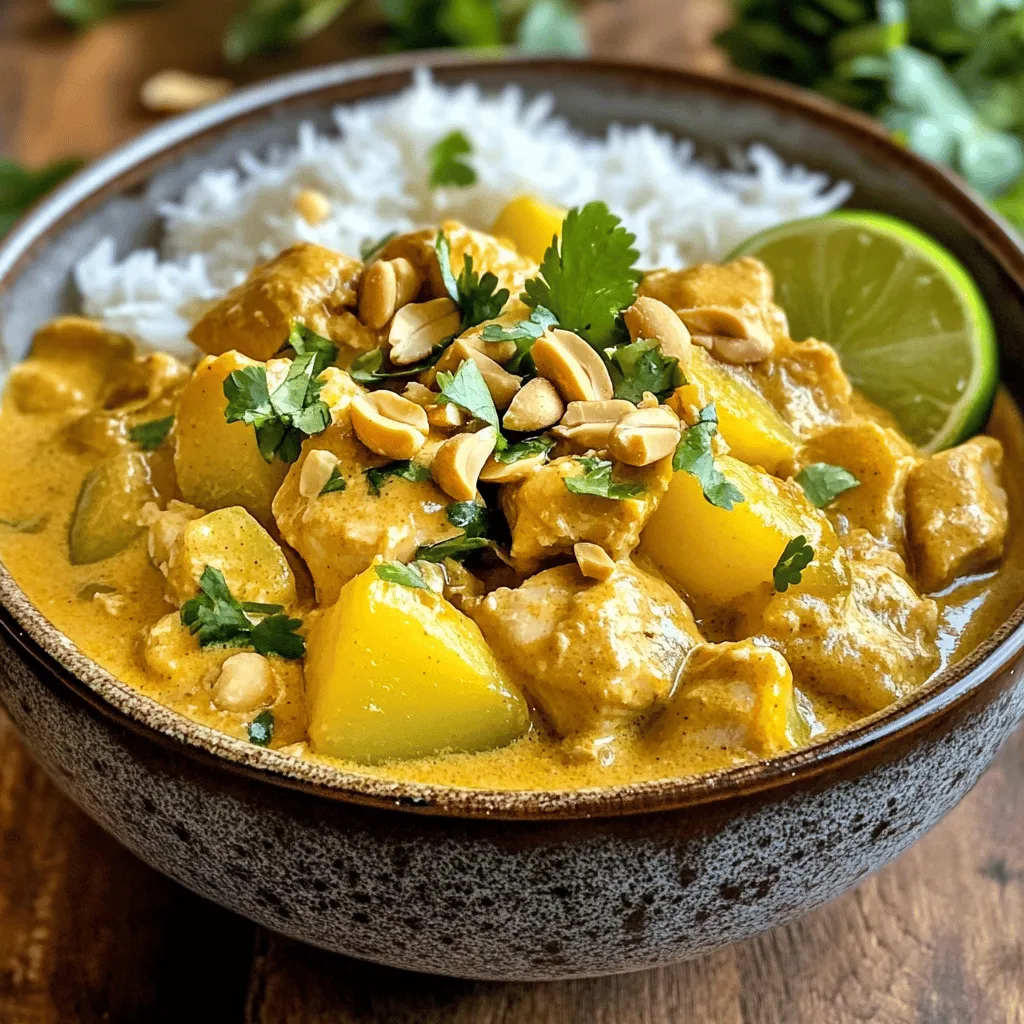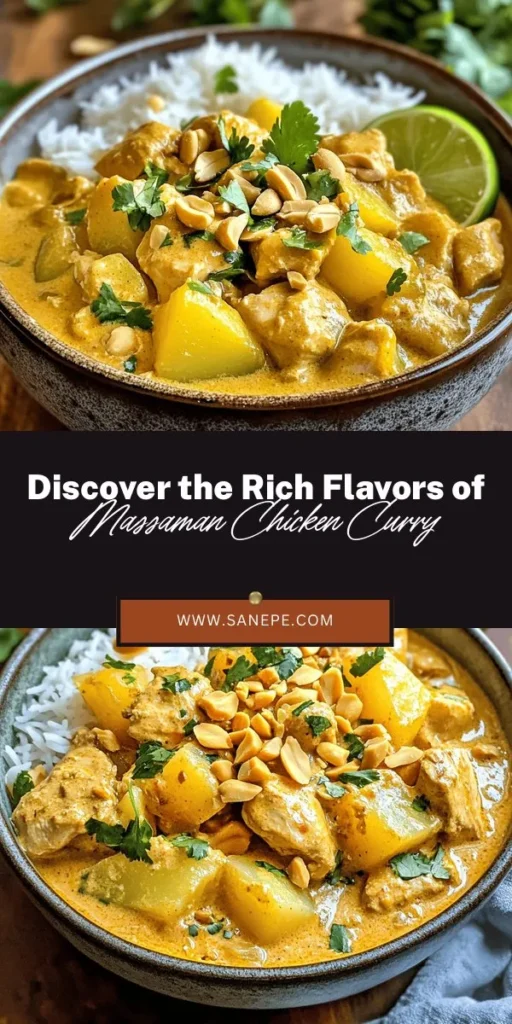Introduction to Massaman Chicken Curry Delight
Massaman Chicken Curry is a warm, comforting dish infused with rich flavors and a unique blend of spices. Originating from Thailand, this recipe combines the savory taste of tender chicken thighs with the creamy richness of coconut milk, making it an unforgettable meal for any occasion. As one of the most beloved curries in Thai cuisine, Massaman Curry stands out not only for its delicious taste but also for its fascinating history and cultural significance. In this article, we will delve into the nuances of preparing this delightful dish, exploring its ingredients, cooking techniques, and the story behind its creation. Whether you’re an experienced cook or a novice in the kitchen, this guide will provide you with everything you need to create the perfect Massaman Chicken Curry.
Understanding Massaman Curry
Exploring the History and Origins of Massaman Curry
The origins of Massaman Curry trace back to the 17th century, with influences from Indian and Persian cuisine. The name “Massaman” is believed to be derived from the word “Muslim,” as the dish was brought to Thailand by Muslim traders. Historically, Massaman Curry was a royal dish enjoyed by Thai royalty, showcasing its rich heritage and cultural importance. It symbolizes the harmonious blend of different culinary traditions, making it a true representation of Thailand’s diverse food culture.
Massaman Curry is characterized by its use of a variety of spices that are not typically found in other Thai curries. This includes cardamom, cinnamon, cloves, and nutmeg, which contribute to its distinct flavor profile. These spices, combined with the savory notes from the meat and the creaminess of coconut milk, create a delightful balance that tantalizes the taste buds.
The Unique Flavor Profile of Massaman Curry
What sets Massaman Curry apart from other Thai curries is its elaborate flavor profile. The combination of sweet, savory, and aromatic elements makes it a unique culinary experience. The key ingredients that define its taste include:
– Coconut Milk: A staple in Thai cuisine, coconut milk adds a creamy texture and sweetness to the dish.
– Massaman Curry Paste: This essential component is a blend of spices and herbs, providing depth and complexity to the curry.
– Meat Selection: Tender chicken thighs are typically used, as they absorb flavors well and remain juicy during cooking. However, other proteins, such as beef or tofu, can also be substituted.
Compared to other Thai curries like Green or Red Curry, which are often spicier and more herbaceous, Massaman Curry offers a milder and more aromatic experience. This makes it a fantastic option for those who enjoy a rich, comforting dish without overwhelming heat.
Ingredients Breakdown
Essential Ingredients for Massaman Chicken Curry
Now that we have explored the background of Massaman Chicken Curry, it’s time to dive into the essential ingredients that make this dish a culinary masterpiece. Here’s an overview of the key components:
1. Boneless Chicken Thighs: The star of the dish, chicken thighs provide a tender and flavorful base.
2. Massaman Curry Paste: A pre-made or homemade blend of spices that includes chili peppers, garlic, and various aromatic spices.
3. Coconut Milk: The creamy foundation that gives the curry its rich texture.
4. Potatoes: Often included for added heartiness, they absorb flavors and create a satisfying dish.
5. Peanuts: For a crunchy texture and nutty flavor that complements the curry.
6. Onions and Garlic: Essential aromatics that form the base of the dish.
7. Fish Sauce: For a touch of umami and saltiness.
8. Sugar: Balances out the flavors and enhances the dish’s overall taste.
9. Lime Juice: Adds a fresh, zesty note that brightens the flavors.
Each of these ingredients plays a crucial role in defining the taste and nutritional profile of the dish. For instance, chicken thighs are not only flavorful but also high in protein, while coconut milk provides healthy fats that create a satisfying meal.
The Role of the Chicken Thighs
When it comes to the choice of meat for Massaman Chicken Curry, boneless chicken thighs are preferred over chicken breasts for several reasons. Firstly, chicken thighs are more forgiving when it comes to cooking time, as they remain juicy and tender even if cooked slightly longer. Secondly, the higher fat content in thighs enhances the richness of the curry, contributing to the overall flavor.
For those with different dietary needs, there are several alternatives to chicken thighs. You can use:
– Chicken Breasts: A leaner option, but be careful not to overcook them as they can dry out.
– Beef or Lamb: Traditional choices that provide a heartier flavor, though they may require longer cooking times.
– Tofu: A great vegetarian option that absorbs the curry flavors beautifully.
Understanding Massaman Curry Paste
Massaman curry paste is a fundamental component of this dish, providing the unique flavor that defines it. Typically made from a mix of dried chili peppers, garlic, lemongrass, shallots, and various spices, this paste can be purchased pre-made or made from scratch. When choosing a store-bought version, look for one that contains high-quality ingredients without artificial additives.
If you prefer to make your own Massaman curry paste, here’s a simple recipe to get you started:
Homemade Massaman Curry Paste Recipe:
– 5 dried red chilies, soaked and seeds removed
– 1 teaspoon cumin seeds
– 1 teaspoon coriander seeds
– 1/2 teaspoon black peppercorns
– 1/2 teaspoon cardamom seeds
– 1 stick of cinnamon
– 4 cloves of garlic
– 2 shallots
– 1 teaspoon shrimp paste (optional)
– 1 tablespoon vegetable oil
Blend all these ingredients together until a smooth paste forms. Adjust the quantities to suit your taste preferences.
The Creamy Base: Coconut Milk
Coconut milk is integral to Massaman Chicken Curry, not only for its creamy texture but also for its ability to balance the dish’s flavors. In Thai cuisine, coconut milk is often used to create rich and comforting dishes, adding a natural sweetness that complements the spices.
When selecting coconut milk, opt for full-fat varieties for the best flavor and richness. Light coconut milk can be used for a lower-calorie option, but it may not provide the same depth of flavor. If you want to make the dish even more luxurious, consider adding a splash of coconut cream at the end of cooking.
Preparation Steps
Preparing Your Ingredients
Before diving into the cooking process, it’s essential to prepare your ingredients properly. This step is critical in ensuring a smooth cooking experience. Here are some preparation tips:
– Chop the Chicken: Cut the boneless chicken thighs into bite-sized pieces. This allows for even cooking and better flavor absorption.
– Dice the Vegetables: Peel and dice the potatoes into uniform pieces to ensure they cook evenly. Chop the onions and mince the garlic finely.
– Prepare the Curry Paste: If you’re using homemade Massaman curry paste, make sure it’s ready to go before you start cooking.
Taking the time to prep your ingredients will not only save you time during the cooking process but also lead to a more enjoyable cooking experience.
Cooking Techniques for Massaman Chicken Curry
Now that your ingredients are prepped, it’s time to begin the cooking process. Here are the essential cooking techniques you’ll need to master for the perfect Massaman Chicken Curry:
1. Sautéing Fundamentals: Onions and Garlic
– In a large pot or Dutch oven, heat a tablespoon of oil over medium heat.
– Add the diced onions and sauté until they become translucent, about 5 minutes.
– Stir in the minced garlic and cook for an additional minute, until fragrant.
2. Browning Chicken for Enhanced Flavor
– Increase the heat to medium-high and add the chopped chicken thighs to the pot.
– Sear the chicken until browned on all sides, about 5-7 minutes. This step is crucial as it develops the flavor base of the curry.
By following these initial steps carefully, you set the stage for a delicious Massaman Chicken Curry that is sure to impress anyone at the dinner table. In the next sections, we will continue with more detailed cooking instructions and tips on how to perfect this iconic Thai dish.

Creating the Perfect Curry Base
Incorporating the Curry Paste: Timing and Techniques
The foundation of a great Massaman chicken curry lies in the curry paste. This blend of spices is what truly gives the dish its unique flavor and aroma. Start by heating a tablespoon of coconut oil in a large pot or Dutch oven over medium heat. Once the oil is hot, add the Massaman curry paste. Sauté the paste for about 2-3 minutes, allowing it to cook and release its essential oils. This step is crucial as it enhances the flavors and ensures that the spices bloom, creating a more aromatic base for your curry.
After sautéing the paste, it’s important to gradually incorporate your coconut milk. Pour in about half of the coconut milk initially and stir well to combine it with the curry paste. This will create a rich and creamy base that is essential for the dish. Allow the mixture to come to a gentle simmer before adding the chicken and other ingredients.
Balancing Flavors with Fish Sauce, Brown Sugar, and Tamarind
To achieve the authentic flavor profile of Massaman curry, it’s essential to balance the sweet, salty, and tangy notes. Once your chicken has been added and is starting to cook, season the curry with fish sauce, which adds a savory umami flavor. Start with one tablespoon and adjust according to taste—remember, you can always add more, but you can’t take it out once it’s in!
Next, introduce a tablespoon of brown sugar to the mix. This will counterbalance the saltiness of the fish sauce and add a hint of sweetness that complements the richness of the coconut milk. Finally, a teaspoon of tamarind paste will introduce a subtle tanginess, elevating the overall flavor complexity of your curry.
Simmering to Perfection
The Significance of Simmering in Curry-Making
Simmering is a crucial step in making a flavorful Massaman chicken curry. Once you have added all your ingredients, including the remaining coconut milk, bring the mixture to a boil. After reaching a boil, reduce the heat to low and let it simmer. This slow cooking process allows the flavors to meld beautifully, giving the curry its signature depth and richness.
Allow the curry to simmer for at least 30 minutes, stirring occasionally to prevent sticking. As it cooks, the chicken will absorb the flavors of the spices, and the potatoes will become tender, adding a comforting texture to the dish.
Tips for Checking Doneness of Chicken and Potatoes
To ensure that your curry is cooked to perfection, it’s essential to check the doneness of both the chicken and potatoes. The chicken should be cooked through, reaching an internal temperature of 165°F (75°C). You can check this by cutting into a piece of chicken; it should be no longer pink in the center.
The potatoes should be fork-tender, which usually takes about 20-25 minutes of simmering. If they easily fall apart when pierced with a fork, they are ready. If you find that the curry is too thick, you can add a little water or additional coconut milk to reach your desired consistency.
Serving Suggestions
Garnishing Your Massaman Chicken Curry
Presentation is key when serving Massaman chicken curry. Fresh cilantro sprinkled on top adds a vibrant green color and a burst of freshness that perfectly complements the rich flavors of the dish. Additionally, serving lime wedges on the side allows guests to add a splash of acidity, enhancing the overall taste.
For a more visually appealing dish, consider serving the curry in a large shallow bowl. This allows for a generous portion of the curry, showcasing the tender chicken and vibrant potatoes. A sprinkle of chopped roasted peanuts can add a delightful crunch and an earthy flavor.
Pairing Your Curry with Sides
Massaman chicken curry is traditionally served with steamed jasmine rice, which acts as a perfect canvas to soak up the rich sauce. The fragrant rice balances the curry’s flavors and adds a delightful texture. However, you can also explore other sides, such as:
– Naan Bread: This Indian flatbread is perfect for scooping up curry.
– Quinoa: A nutrient-dense alternative that adds a nutty flavor.
– Cucumber Salad: A refreshing side that helps to cut through the richness of the curry.
Variations and Customizations
Exploring Vegetarian and Vegan Options
To make a vegetarian or vegan version of Massaman curry, consider substituting the chicken with plant-based proteins such as tofu, tempeh, or chickpeas. These alternatives not only provide a satisfying texture but also absorb the flavors of the curry beautifully.
When using tofu, opt for extra-firm tofu, and press it to remove excess moisture before cooking. This will help it maintain its shape and texture in the curry. Adjust the flavors as needed; vegan versions may require a bit more brown sugar or tamarind to maintain the same depth of flavor.
Spicing It Up: Adjusting Heat Levels
For those who enjoy a bit more heat in their dishes, you can easily modify the recipe. Consider adding sliced fresh chili peppers or a pinch of red pepper flakes along with the curry paste for an extra kick. If you want to keep it mild, you can always serve fresh sliced chilies on the side, allowing guests to add heat to their liking.
Additionally, feel free to incorporate more vegetables into your curry. Bell peppers, green beans, or carrots not only enhance the nutritional value but also add vibrant colors and textures to the dish.
The Cultural Significance of Massaman Curry
Massaman Curry in Thai Culture
Massaman curry holds a special place in Thai culinary tradition. Originally influenced by Persian cuisine, it is considered a royal dish, often served during special occasions and family gatherings. Its rich flavors and unique ingredients reflect the harmony of Thai culture, where sweet, sour, salty, and spicy flavors coexist beautifully.
During festivals, especially during the Lunar New Year, Massaman curry is often prepared to symbolize prosperity and abundance. Sharing a meal that includes this curry brings families together, fostering a sense of community and joy.
Global Influence and Adaptation
As Massaman curry has traveled beyond Thailand, it has adapted to various cultures, creating delightful variations. In Western countries, it is common to find recipes that include different proteins or additional spices that cater to local tastes. Despite these adaptations, the essence of the dish remains rooted in its Thai origins.
Modern twists on the classic Massaman curry include using local ingredients or incorporating international cooking techniques, further showcasing the dish’s versatility and global appeal. Whether enjoyed in a traditional setting or with a contemporary flair, Massaman curry continues to captivate food lovers around the world.
Conclusion
Massaman Chicken Curry Delight is more than just a dish; it is a celebration of flavors, history, and culture. With its rich and comforting profile, this recipe is sure to become a favorite in your household. By understanding the ingredients, preparation techniques, and cultural significance, you can appreciate the depth and richness that this dish brings to the table.
Whether enjoyed on a cozy night in or shared with friends, Massaman Chicken Curry is a testament to the beauty of global cuisine. Embrace the culinary journey and savor every bite of this delightful dish, knowing that you are part of a rich tradition that spans across continents and generations.


